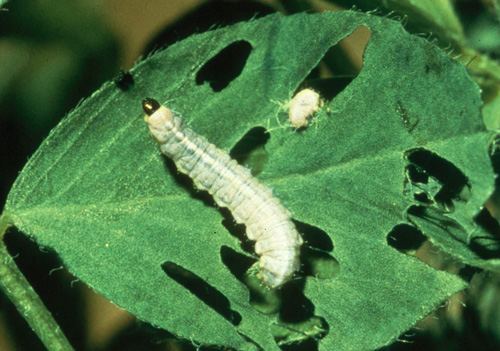Alfalfa Weevil Thermal Model
Identification
Alfalfa weevil adults are small (1/4 inch), light brown in color with a darker brown v-shaped "shield" on their back. Larvae have a black head, a white stripe down their back and will grow to a length of 3/8 inches. Larvae are slate-colored when small but will eventually turn green.
Life Cycle
Alfalfa weevils overwinter as adults in plant debris along fence rows, ditch banks, woodlots, etc. Starting with the first warm spring days they migrate to alfalfa fields and lay eggs in new or dead plant stems. Peak egg lay and larval feeding is usually around early and late May, respectively. Larvae spin a white silken cocoon when development is complete and adults emerge within two weeks. Newly emerged adults will feed on alfalfa foliage for a short time before migrating out of the field to their summer "hibernation" sites. Adult weevils are not active during the summer months but occasionally will be collected in sweep nets.
By using degree days (sine calculation, base 48 F) crop advisors and field scouts can monitor alfalfa weevil activity. Begin scouting activity at egg hatch. An additional 295 degree days are required to complete larval development (see table below).
| Stage of Development | Degree Days Required to Complete Indicated Life Stage | Accumulated Degree Days |
|---|---|---|
| egg | 300 | 300 |
| 1st instar | 71 | 371 |
| 2nd instar | 67 | 438 |
| 3rd instar | 66 | 504 |
| 4th instar | 91 | 595 |
| pupa | 219 | 814 |
Damage
Some larvae cause damage by chewing tiny holes in the upper leaves. As larvae grow, the amount of foliage consumed increases dramatically. When larval numbers are high, complete defoliation of the upper leaves can occur. Peak damage often occurs when the first cutting is ready for harvest. Significant yield loss can also occur when larvae and/or adults feed on second crop regrowth. Feeding is usually completed by the time second crop regrowth is 8-10 inches tall.
Scouting and Economic Threshold
Start monitoring alfalfa at 300 degree days. Spot-check sandy knolls or fields with south facing slopes and look for tiny pin-holes in the upper leaves. Unfold newly emerged leaves and look for larvae. Spot checking will help determine when to start detailed scouting of all fields.
To make a detailed evaluation of first crop weevil damage, walk an M-shaped pattern and collect 50 stems at random. When finished, carefully look over each stem for signs of weevil feeding. Count all stems that show signs of feeding and divide that number by 50 (total number of stems initially collected) to determine percentage tip feeding. Control is suggested when 40% or more of the stems show signs of weevil feeding.
Check alfalfa regrowth 4-5 days after cutting for signs of weevil injury. Remember that dry weather, as well as weevil feeding, can delay regrowth. Look for larvae (or adults) on the soil surface around alfalfa crowns. They often can be found under leaf litter or at the juncture between soil and crown. During cool, cloudy weather you may find them feeding on new alfalfa buds during daylight hours. It is difficult to make control decisions based on the number of larvae found. A better method is to take another stem sample, as you did with first crop, and treat the field when 50% of the stems have feeding injury. Before deciding to spray, use an insect sweet net to make sure weevils are still present. Natural control factors can significantly reduce weevil numbers or the weevils may have formed a cocoon and will no long be causing damage.
Control Methods
If 40% tip feeding is found more than 7-10 days ahead of the suggested harvest date, the field should be sprayed as soon as possible. Although "early" harvest is an excellent way of killing alfalfa weevil larvae, harvesting too early could be detrimental to alfalfa stands. Also, growers may not be able to harvest fast enough to stay ahead of the weevil in years of high abundance. In these cases, growers may have to spray the most heavily infested fields and harvest those with lighter infestations. There are a number of insecticides registered for alfalfa weevil larval control. However, if you have adult weevils, select an insecticide that is labeled for adult control. For more information regarding insecticides labeled for alfalfa weevil control, consult University of Wisconsin-Extension bulletin number A3646 "Field Crop Pest Management in Wisconsin" which is available from your local county extension office. Pay close attention to pre-harvest restrictions. These restriction vary according to the insecticide used and the rate at which it is applied. When selecting insecticides, consider price, potential hazards to honey bees and whether or not it is a restricted use pesticide. Read the label carefully before applying any pesticide.
There are several natural enemies that do an excellent job of controlling the alfalfa weevil. Which is why insecticides are recommended only as a last resort and then only when significant yield losses are unavoidable. Several small, non-stinging species of wasps have been introduced by the Wisconsin Department of Agriculture, Trade and Consumer Protection and can be responsible for keeping weevil populations below treatment levels. There is also a fungal pathogen that attacks weevil larvae and can decimate weevil populations in a few days. Although these natural control factors are effective, conditions may not always be favorable for acceptable results. Always use timely field scouting before making control recommendations.
